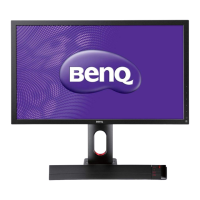
Do you have a question about the BenQ XL2720T and is the answer not in the manual?
| 3D | - |
|---|---|
| Panel type | TN+Film |
| Pixel pitch | 0.311 x 0.311 mm |
| Aspect ratio | 16:9 |
| Display diagonal | 27 \ |
| Display technology | LED |
| Viewing angle, vertical | 160 ° |
| Contrast ratio (dynamic) | 12000000:1 |
| Contrast ratio (typical) | 1000:1 |
| Display number of colors | 16.78 million colors |
| Viewing angle, horizontal | 170 ° |
| Display brightness (typical) | 300 cd/m² |
| Supported graphics resolutions | 1920 x 1080 (HD 1080) |
| HDCP | Yes |
| USB Type-A downstream ports quantity | 0 |
| Tilt angle range | -5 - 20 ° |
| Number of OSD languages | 17 |
| Panel mounting interface | 100 x 100 mm |
| AC input voltage | 95 - 265 V |
| Power consumption (standby) | - W |
| Power consumption (typical) | 27 W |
| Power consumption (PowerSave) | 0.5 W |
| Product color | Black, Red |
| Market positioning | Gaming |
| Windows operating systems supported | Windows 7 Home Basic, Windows 7 Home Basic x64, Windows 7 Home Premium, Windows 7 Home Premium x64, Windows 7 Professional, Windows 7 Professional x64, Windows 7 Starter, Windows 7 Starter x64, Windows 7 Ultimate, Windows 7 Ultimate x64, Windows 8, Windows 8 Enterprise, Windows 8 Enterprise x64, Windows 8 Pro, Windows 8 Pro x64, Windows 8 x64 |
| Depth (without stand) | 273 mm |
|---|---|
| Width (without stand) | 642 mm |
| Height (without stand) | 548 mm |
| Weight (without stand) | 7500 g |
Follow safety instructions for monitor performance and longevity.
Step-by-step instructions for securing the monitor base.
Attaching the base for specific models.
Attaching the base for specific models.
Finalizing the monitor-to-stand connection.
Initial guidance on monitor height adjustment.
Connecting the monitor via D-Sub.
Connecting the monitor via DVI-D Dual Link.
Connecting the monitor via HDMI.
Connecting the monitor via DisplayPort.
Steps to connect the monitor's power cord.
Procedures for turning on the monitor and computer.
Guide through Windows' Found New Hardware wizard.
Steps for selecting and installing drivers from CD.
Steps for updating existing monitor drivers.
Links to guides for Windows 8, 7, and Vista.
Steps to open display settings in Windows 7.
Steps to open display settings in Windows Vista.
Process for updating the driver via Device Manager.
Step-by-step guide to set the monitor to 120 Hz.
Choosing modes like Standard, FPS1, Movie, Photo.
Adjusting core image quality parameters.
Enhancing dark areas, tone, and color tint.
Choosing modes like Standard, FPS1, RTS.
Troubleshooting image color problems.
Steps to fix image blurriness.
Understanding and addressing pixel defects.
Resolving "Out of Range" messages.
Fixing distorted, flashing, or displaced images.